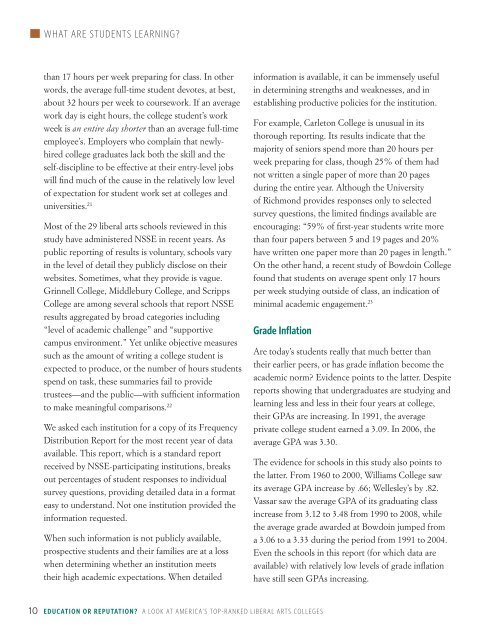k4yqkhk
k4yqkhk
k4yqkhk
You also want an ePaper? Increase the reach of your titles
YUMPU automatically turns print PDFs into web optimized ePapers that Google loves.
WHAT ARE STUDENTS LEARNING?than 17 hours per week preparing for class. In otherwords, the average full-time student devotes, at best,about 32 hours per week to coursework. If an averagework day is eight hours, the college student’s workweek is an entire day shorter than an average full-timeemployee’s. Employers who complain that newlyhiredcollege graduates lack both the skill and theself-discipline to be effective at their entry-level jobswill find much of the cause in the relatively low levelof expectation for student work set at colleges anduniversities. 21Most of the 29 liberal arts schools reviewed in thisstudy have administered NSSE in recent years. Aspublic reporting of results is voluntary, schools varyin the level of detail they publicly disclose on theirwebsites. Sometimes, what they provide is vague.Grinnell College, Middlebury College, and ScrippsCollege are among several schools that report NSSEresults aggregated by broad categories including“level of academic challenge” and “supportivecampus environment.” Yet unlike objective measuressuch as the amount of writing a college student isexpected to produce, or the number of hours studentsspend on task, these summaries fail to providetrustees—and the public—with sufficient informationto make meaningful comparisons. 22We asked each institution for a copy of its FrequencyDistribution Report for the most recent year of dataavailable. This report, which is a standard reportreceived by NSSE-participating institutions, breaksout percentages of student responses to individualsurvey questions, providing detailed data in a formateasy to understand. Not one institution provided theinformation requested.When such information is not publicly available,prospective students and their families are at a losswhen determining whether an institution meetstheir high academic expectations. When detailedinformation is available, it can be immensely usefulin determining strengths and weaknesses, and inestablishing productive policies for the institution.For example, Carleton College is unusual in itsthorough reporting. Its results indicate that themajority of seniors spend more than 20 hours perweek preparing for class, though 25% of them hadnot written a single paper of more than 20 pagesduring the entire year. Although the Universityof Richmond provides responses only to selectedsurvey questions, the limited findings available areencouraging: “59% of first-year students write morethan four papers between 5 and 19 pages and 20%have written one paper more than 20 pages in length.”On the other hand, a recent study of Bowdoin Collegefound that students on average spent only 17 hoursper week studying outside of class, an indication ofminimal academic engagement. 23Grade InflationAre today’s students really that much better thantheir earlier peers, or has grade inflation become theacademic norm? Evidence points to the latter. Despitereports showing that undergraduates are studying andlearning less and less in their four years at college,their GPAs are increasing. In 1991, the averageprivate college student earned a 3.09. In 2006, theaverage GPA was 3.30.The evidence for schools in this study also points tothe latter. From 1960 to 2000, Williams College sawits average GPA increase by .66; Wellesley’s by .82.Vassar saw the average GPA of its graduating classincrease from 3.12 to 3.48 from 1990 to 2008, whilethe average grade awarded at Bowdoin jumped froma 3.06 to a 3.33 during the period from 1991 to 2004.Even the schools in this report (for which data areavailable) with relatively low levels of grade inflationhave still seen GPAs increasing.10 EDUCATION OR REPUTATION? A look at America’s Top-raNKed Liberal Arts COLLEGES


